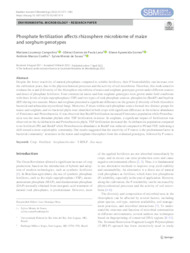Phosphate fertilization affects rhizosphere microbiome of maize and sorghum genotypes.
Phosphate fertilization affects rhizosphere microbiome of maize and sorghum genotypes.
Author(s): CAMPOLINO, M. L.; LANA, U. G. de P.; GOMES, E. A.; COELHO, A. M.; SOUSA, S. M. de
Summary: Despite the lower reactivity of natural phosphates compared to soluble fertilizers, their P bioavailability can increase over the cultivation years, due to the physicochemical processes and the activity of soil microbiota. Therefore, this work aimed to evaluate the ? and ? diversity of the rhizosphere microbiota of maize and sorghum genotypes grown under diferent sources and doses of phosphate fertilizers. Four commercial maize and four sorghum genotypes were grown under feld conditions with three levels of triple superphosphate (TSP) and two types of rock phosphate sources: phosphorite (RockP) and bayóvar (RP) during two seasons. Maize and sorghum presented a signifcant diference on the genetic ? diversity of both rhizosferic bacterial and arbuscular mycorrhizal fungi. Moreover, P doses within each phosphate source formed two distinct groups for maize and sorghum, and six bacterial phyla were identifed in both crops with signifcant diference in the relative abundance of Firmicutes and Proteobacteria. It was observed that RockP fertilization increased Firmicutes population while Proteobacteria was the most abundant phylum after TSP fertilization in maize. In sorghum, a signifcant impact of fertilization was observed on the Acidobacteria and Proteobacteria phyla. TSP fertilization increased the Acidobacteria population compared to no fertilized (P0) and RockP while Proteobacteria abundance in RockP was reduced compared to P0 and TSP, indicating a shift toward a more copiotrophic community. Our results suggested that the reactivity of P source is the predominant factor in bacterial community' structures in the maize and sorghum rhizosphere from the evaluated genotypes, followed by P source.
Publication year: 2022
Types of publication: Journal article
Unit: Embrapa Maize & Sorghum
Keywords: Adubo, Crops, Fertilizante Fosfatado, Fertilizers, Milho, Sorghum Bicolor, Sorgo, T-RFLP, Zea Mays
Observation
Some of Embrapa's publications are published as ePub files. To read them, use or download one of the following free software options to your computer or mobile device. Android: Google Play Books; IOS: iBooks; Windows and Linux: Calibre.
Access other publications
Access the Agricultural Research Database (BDPA) to consult Embrapa's full library collection and records.
Visit Embrapa Bookstore to purchase books and other publications sold by Embrapa.

